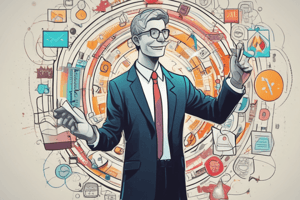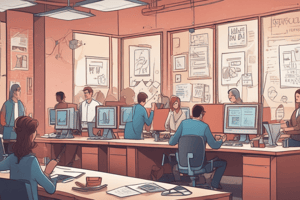Podcast
Questions and Answers
What aspect of Maslow's Hierarchy of Needs addresses the need for career advancement opportunities?
What aspect of Maslow's Hierarchy of Needs addresses the need for career advancement opportunities?
- Self-actualization (correct)
- Safety
- Esteem
- Physiological
In the context of Equity Theory, what can demotivate an employee when they perceive an inequality in their compensation?
In the context of Equity Theory, what can demotivate an employee when they perceive an inequality in their compensation?
- Feeling undervalued despite similar contributions (correct)
- Absence of team-building activities
- Lack of feedback from managers
- High workload without recognition
How does the Job Enrichment approach increase motivation in employees?
How does the Job Enrichment approach increase motivation in employees?
- By providing repetitive tasks
- By limiting their responsibilities
- By offering a sense of ownership and collaboration opportunities (correct)
- By removing decision-making authority
What is a key characteristic of the 'Performing' stage in Tuckman's Model of Team Development?
What is a key characteristic of the 'Performing' stage in Tuckman's Model of Team Development?
Which conflict resolution technique is best illustrated by discussing and offering support for a member who misses deadlines?
Which conflict resolution technique is best illustrated by discussing and offering support for a member who misses deadlines?
Which leadership style is exemplified when a manager initially directs a new employee and later delegates tasks as the employee becomes more confident?
Which leadership style is exemplified when a manager initially directs a new employee and later delegates tasks as the employee becomes more confident?
What is the primary action taken by a manager to resolve team dysfunction due to mistrust among members?
What is the primary action taken by a manager to resolve team dysfunction due to mistrust among members?
What is a benefit of setting specific goals, as per Goal-Setting Theory?
What is a benefit of setting specific goals, as per Goal-Setting Theory?
Which of the following is not a stage in Maslow's Hierarchy of Needs?
Which of the following is not a stage in Maslow's Hierarchy of Needs?
What distinguishes motivators from hygiene factors in Herzberg's Two-Factor Theory?
What distinguishes motivators from hygiene factors in Herzberg's Two-Factor Theory?
In Deci and Ryan's Self-Determination Theory, which of the following is not one of the basic psychological needs?
In Deci and Ryan's Self-Determination Theory, which of the following is not one of the basic psychological needs?
Which of the following leadership styles primarily focuses on exchanges of performance for rewards?
Which of the following leadership styles primarily focuses on exchanges of performance for rewards?
Which approach is most effective for overcoming cross-cultural communication barriers?
Which approach is most effective for overcoming cross-cultural communication barriers?
What is a primary goal of relationship-oriented leadership?
What is a primary goal of relationship-oriented leadership?
Which of the following is considered a nonverbal communication skill?
Which of the following is considered a nonverbal communication skill?
In the context of conflict management, which technique focuses on collaborative problem-solving?
In the context of conflict management, which technique focuses on collaborative problem-solving?
What is the primary focus of a leader compared to a manager?
What is the primary focus of a leader compared to a manager?
During which stage of Tuckman's model do team members typically experience conflict as they assert their opinions?
During which stage of Tuckman's model do team members typically experience conflict as they assert their opinions?
What type of conflict can lead to innovative solutions within a team?
What type of conflict can lead to innovative solutions within a team?
Which of the following best describes a project team?
Which of the following best describes a project team?
What signifies the adjourning stage in Tuckman's model?
What signifies the adjourning stage in Tuckman's model?
Which dysfunction is characterized by team members withholding information due to fear of criticism?
Which dysfunction is characterized by team members withholding information due to fear of criticism?
Which of the following illustrates the norming stage of team development?
Which of the following illustrates the norming stage of team development?
How does a virtual team primarily operate?
How does a virtual team primarily operate?
Flashcards
Team
Team
A cohesive group working together with shared goals and mutual accountability.
Team Development Stages
Team Development Stages
Tuckman's model (Forming, Storming, Norming, Performing, Adjourning) describes the typical stages a team goes through.
Project Team
Project Team
A temporary team assembled to accomplish a specific project.
Dysfunctional Conflict
Dysfunctional Conflict
Signup and view all the flashcards
Functional Conflict
Functional Conflict
Signup and view all the flashcards
Virtual Team
Virtual Team
Signup and view all the flashcards
Leadership
Leadership
Signup and view all the flashcards
Management
Management
Signup and view all the flashcards
Maslow's Hierarchy
Maslow's Hierarchy
Signup and view all the flashcards
Equity Theory
Equity Theory
Signup and view all the flashcards
Goal-Setting Theory
Goal-Setting Theory
Signup and view all the flashcards
Job Enrichment
Job Enrichment
Signup and view all the flashcards
Forming Stage
Forming Stage
Signup and view all the flashcards
Storming Stage
Storming Stage
Signup and view all the flashcards
Norming Stage
Norming Stage
Signup and view all the flashcards
Performing Stage
Performing Stage
Signup and view all the flashcards
Task-Oriented Leadership
Task-Oriented Leadership
Signup and view all the flashcards
Relationship-Oriented Leadership
Relationship-Oriented Leadership
Signup and view all the flashcards
Transactional Leadership
Transactional Leadership
Signup and view all the flashcards
Transformational Leadership
Transformational Leadership
Signup and view all the flashcards
Ethical Leadership
Ethical Leadership
Signup and view all the flashcards
Encoding
Encoding
Signup and view all the flashcards
Active Listening
Active Listening
Signup and view all the flashcards
Maslow's Hierarchy of Needs
Maslow's Hierarchy of Needs
Signup and view all the flashcards
Study Notes
Motivation Theories
- Maslow's Hierarchy of Needs: Physiological, safety, love/belonging, esteem, and self-actualization needs.
- Herzberg's Two-Factor Theory: Motivators (achievement, recognition) enhance satisfaction and are separate from hygiene factors (salary, policies).
- Deci and Ryan's Self-Determination Theory: Emphasizes autonomy, competence, and relatedness for motivation.
- Equity Theory: Fairness is key; employees compare input/output ratios with peers.
- Expectancy Theory: Motivation depends on expectancy (effort→performance), instrumentality (performance→rewards), and valence (value of reward).
- Goal-Setting Theory: Specific and challenging goals enhance motivation and performance.
Job Design Approaches
- Traditional approach: Simplification for efficiency.
- Modern approaches: Job rotation, enlargement, enrichment.
Behavior Modification and Rewards
- Reinforcement theory: Positive/negative reinforcement, punishment, extinction.
- Compensation strategies: Performance-based pay, intrinsic rewards.
- Application: Interim goals, milestone celebrations, value alignment.
Managing Teams
- Group vs. Teams : Groups have shared norms and goals, teams have collective performance.
- Stages of Team Development (Tuckman's Model): Forming, storming, norming, performing, adjourning.
- Types of Teams : Project, virtual, cross-functional.
- Conflict Management: Functional conflict (improve decisions), dysfunctional conflict (hinder performance).
- Techniques for conflict resolution: Avoiding, accommodating, forcing, compromising, collaborating.
- Team Dysfunction and Remedies: Address causes like lack of trust, poor communication.
Leadership
- Trait Theories: Inherent traits predict leadership success (charisma, intelligence).
- Behavioral Theories: Task-oriented (setting goals, clarifying roles) and relationship-oriented (building trust).
- Situational Leadership: Adjusting style to follower readiness (directing, coaching, supporting, delegating).
- Transactional vs. Transformational Leadership: Transactional (exchanges for rewards), Transformational (inspire vision).
Communication in Management
- Communication Process: Sender → Encoding → Message → Channel → Decoding → Receiver → Feedback
- Rich vs. Lean Channels: Rich (face-to-face) for complex, Lean (email) for straightforward.
- Barriers to Communication: Physical (noise, distance), personal (differences, lack of trust)
- Cross-cultural (misunderstandings due to differences), nonverbal (misinterpreting cues)
Studying That Suits You
Use AI to generate personalized quizzes and flashcards to suit your learning preferences.




